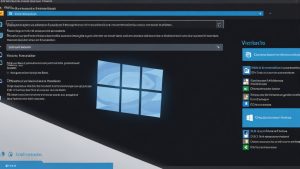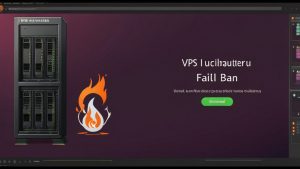How to Effectively Manage Virtual Machine Resources: Optimizing Performance
Virtual machines (VMs) have become an integral part of modern IT infrastructure, providing flexibility, scalability, and resource savings. However, to maximize their potential, you need to carefully manage the resources allocated to them. In this article, we will look at key aspects of virtual machine resource management, with an emphasis on monitoring, optimizing, and effectively allocating resources to ensure stable and productive operation of your applications and services.
Table of Contents
- Monitoring Virtual Machine Performance
- Managing CPU Resources for Virtual Machines
- Optimizing Memory Usage in Virtual Machines
- Managing Disk Space and I/O in Virtual Machines
- Optimizing Network Resources for Virtual Machines
Monitoring Virtual Machine Performance
Effective resource management begins with continuous monitoring of virtual machine performance. Monitoring allows you to identify bottlenecks, predict resource needs, and quickly respond to emerging problems. There are many monitoring tools and methods, both built into virtualization platforms and third-party.
Virtual Machine Monitoring Tools
There is a wide range of tools for monitoring virtual machines, each with its own advantages and disadvantages. The choice of tool depends on the virtualization platform used, the size of the infrastructure, and the requirements for data granularity.
- Built-in virtualization tools: VMware vCenter, Microsoft Hyper-V Manager, Citrix Hypervisor (XenServer) Center provide basic monitoring functionality, including graphs of CPU load, memory usage, disk space, and network activity.
- Server monitoring systems: Zabbix, Nagios, Prometheus, Grafana allow you to collect and analyze data from virtual machines, as well as set thresholds and receive notifications when these values are exceeded.
- Cloud monitoring services: AWS CloudWatch, Azure Monitor, Google Cloud Monitoring provide tools for monitoring virtual machines running in the cloud, as well as integration with other cloud services.
Key Metrics for Monitoring
For effective monitoring, it is necessary to track key metrics that characterize the performance of a virtual machine. Here are some of the most important metrics:
- CPU Load (%): Shows how loaded the virtual machine’s processor is. High load may indicate a lack of processor resources.
- Memory Usage (%): Shows how much memory the virtual machine is using. Lack of memory can lead to slowdowns and the use of a swap file, which significantly reduces performance.
- Disk I/O (read/write operations per second): Shows the intensity of read and write operations to disk. High values may indicate problems with the performance of the disk subsystem.
- Network Activity (bandwidth, packet loss): Shows the amount of traffic transmitted and received by the virtual machine. High network activity or packet loss may indicate problems with the network infrastructure.
- Application Response Time: Shows how long it takes for an application to process a request. This indicator is an important indicator of application performance and can be used to identify resource-related issues.
Example 1: Monitoring CPU using `top` in Linux.
The top command displays dynamic information about the processes running in the system, including CPU usage. You can use this command to monitor the CPU load of a virtual machine and identify processes that consume the most processor resources.
top -n 1The command output will show the total percentage of CPU usage (%Cpu(s):), as well as CPU usage for each process in the system. Pay attention to processes that have high %CPU values.
Example 2: Monitoring memory usage using `free -m` in Linux.
The free -m command displays information about memory usage in the system in megabytes. You can use this command to monitor the total amount of memory, used memory, and available memory in a virtual machine.
free -mThe command output will show the total amount of memory (total), used memory (used), free memory (free), total shared memory (shared), buffers (buff/cache), and available memory (available).
Example 3: Using PowerShell to monitor CPU in Hyper-V.
Get-VM | Get-VMResourceMetrics | Select-Object VMName, CpuUsageAverage, MemoryDemand, MemoryAssignedThis PowerShell command allows you to obtain information about CPU load, required memory, and allocated memory for all virtual machines running on the Hyper-V host.
Managing CPU Resources for Virtual Machines
Managing CPU resources is critical to ensuring the performance of virtual machines. Incorrect allocation of processor resources can lead to a shortage of resources for some VMs and excessive allocation for others, which negatively affects the overall performance of the system.
Methods for Allocating CPU to Virtual Machines
There are several basic methods for allocating CPU to virtual machines:
- Dedicated Core: A virtual machine is allocated an entire physical processor core. This method provides maximum performance, but is inefficient if the VM does not use the core 100%.
- CPU Shares: Virtual machines are allocated shares of processor time relative to each other. For example, if one VM is allocated 2000 shares and another 1000, then the first VM will receive twice as much processor time if both VMs compete for resources.
- CPU Limits: Sets a maximum percentage of CPU usage for a virtual machine. This method prevents a situation where one VM occupies all processor resources and interferes with the operation of other VMs.
Practical Tips for CPU Management
- Determine the needs of each VM: Analyze the CPU load of each VM and determine how many processor resources it actually needs.
- Use CPU shares for prioritization: Allocate more CPU shares to critical VMs to ensure their high performance.
- Limit CPU usage for less important VMs: Set limits on CPU usage for VMs that do not require high performance so that they do not interfere with the operation of more important VMs.
- Configure CPU affinity: Assign virtual machines to specific physical cores to minimize context switching and improve performance.
Example 1: Configuring CPU shares in VMware vSphere.
In vSphere, you can configure CPU shares for each virtual machine in the «Resource Allocation» settings. You can select one of three share levels: Low, Normal, High, or specify a custom value. The higher the share value, the more processor time the virtual machine will receive when competing for resources.
Example 2: Limiting CPU usage in Hyper-V.
You can limit the CPU usage of a virtual machine in Hyper-V using PowerShell:
Set-VMProcessor -VMName "MyVM" -MaximumPercent 50This command limits the CPU usage of the «MyVM» virtual machine to 50% of the total number of processor resources.
Example 3: Configuring CPU affinity in KVM.
You can configure CPU affinity for a KVM virtual machine using the virsh vcpupin command:
virsh vcpupin MyVM 0 1This command pins virtual CPU 0 of the «MyVM» virtual machine to physical CPU 1.
Expert Tip:
Do not overload the virtualization host with too many virtual machines. The optimal number of virtual machines per host depends on the processor power, memory capacity, and disk subsystem, as well as the needs of each VM. Regularly analyze the load on the host and take measures to redistribute the VMs if necessary.
Optimizing Memory Usage in Virtual Machines
Effective memory management is an important aspect of optimizing virtual machine performance. Lack of memory can lead to a swap file, which significantly slows down the VM. Excessive allocation of memory, on the other hand, leads to inefficient use of virtualization host resources.
Memory Optimization Techniques
- Ballooning: A technology that allows the hypervisor to take memory from virtual machines if it is needed by other VMs or the host. Ballooning uses a special driver inside the VM that allocates and releases memory at the request of the hypervisor.
- Deduplication: A technology that allows you to remove duplicate memory blocks, which saves disk space and reduces memory usage.
- Page sharing: A technology that allows virtual machines to share the same memory pages, which also saves memory.
- Memory Overcommitment: Allocating more memory to virtual machines than is available on the host. This technique allows you to increase the density of virtual machines on the host, but can lead to performance problems if all VMs start using all the memory allocated to them at the same time.
Practical Tips for Memory Optimization
- Determine the optimal amount of memory for each VM: Do not allocate more memory to a VM than it actually needs. Use monitoring tools to determine the optimal amount of memory.
- Use ballooning for dynamic memory management: Ballooning allows the hypervisor to dynamically redistribute memory between VMs, ensuring optimal resource utilization.
- Enable deduplication and page sharing: These technologies save memory by removing duplicate memory blocks.
- Be careful with memory overcommitment: Memory overcommitment can be useful for increasing the density of virtual machines, but can lead to performance problems if all VMs start using all the memory allocated to them at the same time. Carefully monitor memory usage and avoid excessive overcommitment.
Example 1: Configuring ballooning in VMware vSphere.
Ballooning is enabled by default in VMware vSphere. Make sure VMware Tools are installed inside the virtual machine for ballooning to work correctly.
Example 2: Monitoring swap file usage in Linux.
You can monitor swap file usage in Linux using the vmstat command:
vmstat 1 5This command displays information about memory and swap file usage every 1 second for 5 seconds. Pay attention to the «si» (swap in) and «so» (swap out) columns. High values in these columns indicate that the virtual machine is actively using the swap file, which can lead to slowdowns.
Example 3: Determining memory consumption by a specific process in Linux.
Use top or ps to find the process PID, and then pmap:
pmap -p PIDReplace PID with the ID of the desired process. This command will show the memory map of the process, including the memory used.
External Link:
Read more about ballooning in the VMware documentation: VMware Documentation (Find the section on memory management).
Managing Disk Space and I/O in Virtual Machines
Effective management of disk space and I/O is critical to ensuring the performance of virtual machines. A slow disk subsystem can become a bottleneck and slow down all VMs using that subsystem. Lack of disk space can lead to the inability to launch a VM or data loss.
Types of Disk Systems
- Local Disk: The virtual machine uses disk space located directly on the virtualization host. This method is easy to set up, but does not provide high availability and scalability.
- NAS (Network Attached Storage): The virtual machine uses disk space located on a NAS network storage. NAS provides higher availability and scalability than a local disk, but can be slower due to network latency.
- SAN (Storage Area Network): The virtual machine uses disk space located on a SAN storage network. SAN provides high performance, availability, and scalability, but is more complex and expensive to set up than NAS.
Practical Tips for Managing Disk Space and I/O
- Use fast disks: For virtual machines that require high disk subsystem performance, use fast disks, such as SSDs.
- Separate the disk subsystem: Divide the disk subsystem into multiple volumes to reduce competition for resources. For example, you can allocate a separate volume for the operating system, applications, and data.
- Use the correct type of disks for each VM: For VMs that do not require high performance, you can use slower and cheaper disks, such as HDDs.
- Monitor Disk I/O: Regularly monitor the disk I/O of each VM and identify VMs that are experiencing disk subsystem performance problems.
- Use thin provisioning: Thin provisioning allows you to allocate more disk space to virtual disks than they actually use. This saves disk space, but can lead to problems if all VMs start using all the disk space allocated to them at the same time.
Example 1: Monitoring disk I/O using `iostat` in Linux.
The iostat command displays information about disk subsystem usage. You can use this command to monitor the number of read and write operations, bandwidth, and disk response time.
iostat -x 1 5This command displays extended I/O statistics every 1 second for 5 seconds. Pay attention to the columns «rrqm/s» (number of read requests merged per second), «wrqm/s» (number of write requests merged per second), «r/s» (number of read operations per second), «w/s» (number of write operations per second), «rsec/s» (number of sectors read per second), «wsec/s» (number of sectors written per second), «await» (average I/O request wait time), and «%util» (percentage of time during which the disk was busy processing I/O requests).
Example 2: Monitoring disk space using `df -h` in Linux.
The df -h command displays information about disk space usage in a human-readable format.
df -hThe command output will show the total amount of disk space (Size), used disk space (Used), available disk space (Avail), and the percentage of disk space used (Use%) for each partition.
Example 3: Thin provisioning in VMware vSphere.
When creating a virtual disk in vSphere, you can select the type of disk space allocation: Thick Provision Eager Zeroed, Thick Provision Lazy Zeroed, or Thin Provision. Select Thin Provision to create a thin disk.
Optimizing Network Resources for Virtual Machines
Optimizing network resources is an important aspect of managing virtual machines, especially in environments with high network load. Incorrect configuration of network parameters can lead to delays, packet loss, and reduced application performance.
Key Factors for Optimizing Network Resources
- Choosing the right type of virtual switch: There are various types of virtual switches, such as standard virtual switches, distributed virtual switches, and Open vSwitch. Each type has its own advantages and disadvantages, and the choice depends on the requirements for performance, security, and scalability.
- Using VLANs: VLANs allow you to segment the network and isolate traffic between different virtual machines. This improves security and improves network performance.
- QoS (Quality of Service): QoS allows you to prioritize network traffic for critical applications. This ensures that important applications receive sufficient bandwidth, even under high network load.
- Offload Technologies: Using hardware offload technologies, such as TCP Segmentation Offload (TSO) and Large Receive Offload (LRO), allows you to offload the virtualization host’s processor and improve network performance.
Practical Tips for Optimizing Network Resources
- Monitor network activity: Regularly monitor the network activity of virtual machines and identify VMs that consume the most network resources.
- Use jumbo frames: Jumbo frames allow you to increase the packet size, which reduces the load on the processor and increases network bandwidth.
- Configure network bonding: Network bonding allows you to combine multiple network interfaces into one logical interface, which increases network availability and bandwidth.
- Use SR-IOV (Single Root I/O Virtualization): SR-IOV allows virtual machines to directly access the network card, bypassing the virtual switch. This significantly improves network performance, but requires support from the network card and virtualization host.
Example 1: Monitoring network activity using `iftop` in Linux.
The iftop command displays information about network activity in real time. You can use this command to monitor the network bandwidth used by each virtual machine.
iftop -i eth0This command displays network activity on the eth0 interface. Pay attention to the IP addresses and bandwidth used by each VM.
Example 2: Configuring VLANs in VMware vSphere.
You can configure VLANs for a virtual machine in vSphere in the «Port Group» settings. Specify the VLAN ID for the port group to assign the virtual machine to the VLAN.
Example 3: Using `ethtool` to view network card settings and enable jumbo frames in Linux.
First, view the current settings:
ethtool eth0Then, if supported, enable jumbo frames (MTU 9000):
ip link set mtu 9000 dev eth0Important: Make sure that all network equipment supports jumbo frames before enabling them.





